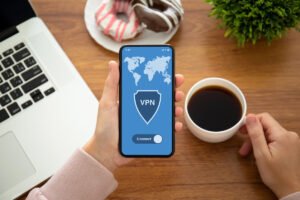We’re going to show you how you can use a DNS content filter called Open DNS to make sure you can filter out the kind of content you deem inappropriate for your home and network. Again, not every home has the same benchmarks and standards for the type of media and content that comes through their network, which is another reason why we like content filters through a DNS.
What DNS Filtering?
First off, what is DNS? The Domain Name System (DNS) is like the phonebook for internet users. We navigate to websites through domain names, such as TMZ or Google. However, web browsers interact with IP Addresses instead. Essentially the DNS translates these numerical codes into human-readable formats so you don’t need to memorize an address that can become outdated over time. Without it, we literally would be lost!
Furthermore, DNS filtering can keep your computer safe from malware and other threats by blocking access to websites that have been determined as harmful or hosting malicious content. This way, the user will basically never receive any file or code which could potentially infect one system with a virus! Depending on the service, setting up a DNS filter is relatively easy (more on that below). We highly recommend a DNS content filter because even though someone could circumvent access to bad content and media, they still won’t be able to do it through your network.
How Can Kids ByPass A DNS Filter?
One way someone can bypass a DNS filter is through the use of a VPN. We’ve talked about VPNs a couple of times. A VPN will take the computer or device and put it on a different virtual network. This new network most likely wouldn’t have the DNS filters set up for those certain websites you wanted to block, essentially rendering your DNS filter on your network useless.
Another clever trick (and maybe not so clever) kids can do to get around a DNS filter is by typing in the IP address directly. For example, if I know that ESPN.com is supposed to be at 45.63. 254.129. I could type those numbers in and that website is going to pop up. And this brings up another interesting topic in and of itself about access to VPNs in your home.
How To Setup Open DNS For Content Filtering
One of our favorite DNS content filters is called OpenDNS. This service is free for home users, which is just awesome. Below are the steps to get you going on this free DNS content filter services (exact instruction may change over time, but the idea is still the same:
- To set up Open DNS, just go to their website.
- From here, go to the “Learn More” button on the Consumer side.
- Once you’re in the consumer section, go to “Open DNS Home” and click “Sign Up”. A little side-note here on free vs paid versions. There is a paid version of OpenDNS which is around $20 a year. It gives you Usage stats and an “Optional Allow-list Mode”, which blocks everything except for the things that you have specifically wanted to allow.
- Go ahead and sign up by entering all the signup information (it’s required…but hey…it’s free).
- You will be directed to a page after signup that will help you set up Open DNS (Set Up OpenDNS On Your Device). When you get to this page you will see the name servers are two IP addresses. This is what you are going to add to your Wi-Fi route. These will be the external DNS servers that you would enter in your Wi-Fi router configuration.
- After you set up your account, you will be directed to this page to help you set up your Wi-Fi router. These are the name servers for OpenDNS and will always be the name servers no matter what your account is. Because of that, you’ll want to write these down (or save them in Notepad and email them to you). You will need to enter them into the appropriate location on your Wi-Fi router or your modem.
- You’ll want to click on “Home Routers” under “Choose Your Device” to get detailed instructions on different types of routers and modems. If your Wi-Fi router or modem is not listed here (and chances are that it might not be…there are thousands of routers), you’ll want to contact your wi-fi router or modem company on how to set a manual DNS on their device.
Further Customizations Through The OpenDNS Dashboard
Once you get your settings and router (or modem) configured properly, click “Test Your Settings”. You will see the OpenDNS dashboard and will be able to see all the stats and logs for your network. It’s kinda cool if you like to geek out on that stuff. You can also change the settings for your particular network as well, which is another nice added benefit of a free DNS content filter. When diving into the Settings (click on “Web Content Filtering”), you can do custom settings and block all of the categories that you want to be blocked. There are a lot of options to customize: gambling, pornography, alcohol, dating, nudity, sexuality, games, ads, weapons, and on and on. We love the custom setting. But if you’re not into dialing down to the specifics, you can choose between High, Moderate, or Low, which all have specific pre-built category filters set in place for you.
The DNS content filter is now set up and ready to operate. It’s not a perfect solution (a little disclaimer) and there are workarounds that someone can do to circumvent the filter, but you’re getting just another added level of protection on what kind of media and content is streaming through your family’s screens. And we like that.








